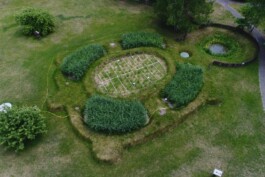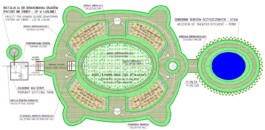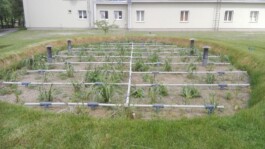
08/24/2023 Photo: Radomir Obroślak
The turtle-shaped hybrid constructed wetland near the Educational and Museum Centre of the Polesie National Park in Stare Załucze was built in 2015 for an average daily capacity of 1 m3/d (Fig. 1). The facility is used to treat domestic wastewater from the Center's employees and tourists.

Figure 1. Hybrid constructed wetland in the Polesie National Park – top view (photo: Radomir Obroślak)
.
The treatment plant was designed in the shape of a turtle (Fig. 2). The European pond turtle (Emys orbicularis) is a relict species, and the Polesie National Park is one of the few habitats for this endangered reptile. The peculiar shape of the constructed wetland catches the eye and provides an opportunity to combine effective treatment of domestic wastewater with raising environmental awareness on biodiversity, the need to protect endangered species and issues of sustainable sanitation. This attractive shape hides the advanced design, which is a combination of constructed wetland beds with different wastewater flow direction and conventional infrastructure.

Figure 2. Hybrid constructed wetland in the Polesie National Park – flow diagram (author: Arkadiusz Malik)
The first part of the treatment process involves mechanical treatment of wastewater in a primary settling tank integrated with a sludge dewatering installation. The settling tank has a form of a rectangular concrete tank. It ensures the removal of solids from wastewater through sedimentation, flotation and digestion processes.
In the second part, wastewater is treated using a biological method in a system of soil–plant beds. The first bed (Fig. 3) has a vertical flow of wastewater (VF) and is planted with manna grass (Glyceria maxima). In the VF–type bed, wastewater is treated by, among others, nitrification and other unitary processes of decomposition and neutralization of pollutants.

Figure 3. The central soil–plant VF bed (photo: Krzysztof Jóźwiakowski)
The second soil–plant beds are characterized by subsurface horizontal wastewater flow (HF) and are planted with common reed (Phragmites australis). In HF–type beds, both sorption and filtration processes take place, as well as microbiological decomposition of pollutants contained in wastewater. Plants overgrowing the constructed wetland beds are mainly responsible for maintaining the appropriate hydraulic conductivity and stimulating the processes of nitrification and denitrification, but they also absorb a small part of the pollutants from wastewater.
In the final stage, removal of phosphorus from wastewater in a special P–filter takes place using carbonate-silica rock (opoka rock), which has the ability to chemically sorb phosphorus compounds.
After all treatment stages, wastewater is discharged into an infiltration pond, which allows for the temporary retention of treated wastewater and the discharge of excess wastewater into the ground. The pond also plays a landscape–forming role, as together with other elements of the treatment plant, it co–creates an unique spatial arrangement, imitating the shape of a turtle (Fig. 4).

Figure 4. Turtle–shaped hybrid constructed wetland in the Polesie National Park (photo: Radomir Obroślak)
Foregoing studies have shown that the hybrid constructed wetland in the Polesie National Park provides a very high removal of organic pollutants, i.e. BOD5 – 99% and COD – 95%, and total suspended solids – 88%, as well as biogenic pollutants (nitrogen and phosphorus): TN – 59% and TP – 99%.
More details on the turtle–shaped constructed wetland can be found on the website of the Polesie National Park: http://www.poleskipn.pl/index.php/badania-i-monitoring/393-hybrydowa-hydrofitowa-oczyszczalnia-sciekow-przy-osrodku-dydaktyczno-muzealnym, and also in the CWetlands platform: https://data.cwetlandsdata.com/cwetlands/overview/357/
Case study description: Karolina Jóźwiakowska – Department of Agricultural, Forestry and Transport Machines, Faculty of Production Engineering, University of Life Sciences in Lublin
Location: Educational and Museum Centre of the Polesie National Park
City: Stare Załucze
State: Lublin Voivodeship
Country: Poland
Project Size:100 m2
Wetland Type (System/Cells):
Hybrid system of the VF–HF type, 1 VF–type bed (42.4 m2) and 4 HF–type beds (4 * 13.8 m2)
Company/Organization: Polesie National Park
Partners





Partners






Duration of the project:
July 1st 2020 - June 30th 2023